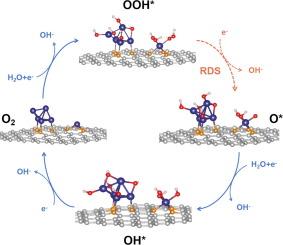Electro-functionalized 2D nitrogen-carbon nanosheets decorated with symbiotic cobalt single-atoms/clusters
IF 13.1
1区 化学
Q1 Energy
引用次数: 0
Abstract
Two-dimensional (2D) materials loaded with single atoms and clusters are being set at the forefront of catalysis due to their distinctive geometric and electronic features. However, the usually-complicated synthesis procedures impede in-depth clarification of their catalytic mechanisms. To this end, herein we developed an efficient one-step dimension-reduction carbonization strategy, with which we successfully architected a highly-efficient catalyst for oxygen reduction reaction (ORR), featured with symbiotic cobalt single atoms and clusters decorated in two-dimensional (2D) ultra-thin (3.5 nm thickness) nitrogen-carbon nanosheets. The synergistic effects of the two components afford excellent oxygen reduction activity in alkaline media (E1/2 = 0.823 V vs. RHE) and thereof a high power density (146.61 mW cm−2) in an assembled Zn-air battery. As revealed by theoretical calculations, the cobalt clusters can regulate electrons surrounding those individual atoms and affect the adsorption of intermediate species. As a consequence, the derived active sites of single cobalt atoms lead to a significant improvement of the ORR performance. Thus, our work may fuel interests to delicate architecture of single atoms and clusters coexisting 2D support toward optimal electrocatalytic performance.

用共生钴单原子/簇装饰的电功能化二维氮碳纳米片
由单个原子和团簇组成的二维(2D)材料因其独特的几何和电子特征而成为催化领域的前沿技术。然而,通常复杂的合成过程阻碍了对其催化机理的深入研究。为此,我们开发了一种高效的一步还原碳化策略,成功地构建了一种高效的氧还原反应(ORR)催化剂,其特点是在二维(2D)超薄(3.5 nm 厚)氮碳纳米片中装饰了共生的钴单原子和团簇。这两种成分的协同效应使其在碱性介质中具有出色的氧还原活性(E1/2 = 0.823 V vs. RHE),并在组装的锌-空气电池中实现了高功率密度(146.61 mW cm-2)。理论计算显示,钴团簇可以调节围绕这些单个原子的电子,并影响中间物质的吸附。因此,单个钴原子衍生出的活性位点显著提高了 ORR 性能。因此,我们的工作可能会激发人们对单个原子和集群共存的二维支持物的微妙结构的兴趣,从而实现最佳的电催化性能。
本文章由计算机程序翻译,如有差异,请以英文原文为准。
求助全文
约1分钟内获得全文
求助全文
来源期刊

Journal of Energy Chemistry
CHEMISTRY, APPLIED-CHEMISTRY, PHYSICAL
CiteScore
19.10
自引率
8.40%
发文量
3631
审稿时长
15 days
期刊介绍:
The Journal of Energy Chemistry, the official publication of Science Press and the Dalian Institute of Chemical Physics, Chinese Academy of Sciences, serves as a platform for reporting creative research and innovative applications in energy chemistry. It mainly reports on creative researches and innovative applications of chemical conversions of fossil energy, carbon dioxide, electrochemical energy and hydrogen energy, as well as the conversions of biomass and solar energy related with chemical issues to promote academic exchanges in the field of energy chemistry and to accelerate the exploration, research and development of energy science and technologies.
This journal focuses on original research papers covering various topics within energy chemistry worldwide, including:
Optimized utilization of fossil energy
Hydrogen energy
Conversion and storage of electrochemical energy
Capture, storage, and chemical conversion of carbon dioxide
Materials and nanotechnologies for energy conversion and storage
Chemistry in biomass conversion
Chemistry in the utilization of solar energy
 求助内容:
求助内容: 应助结果提醒方式:
应助结果提醒方式:


